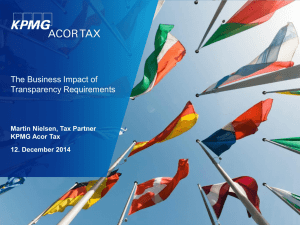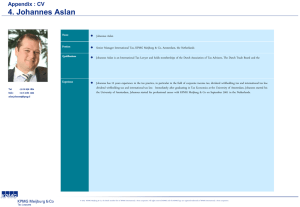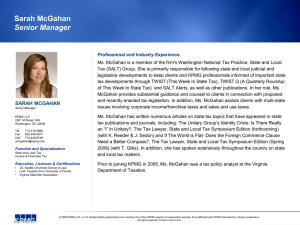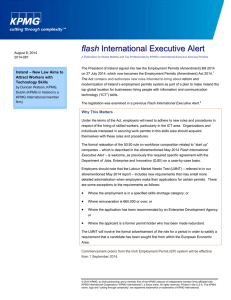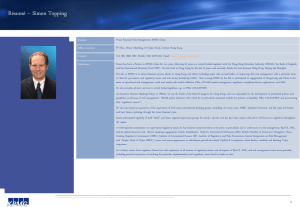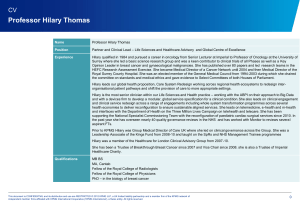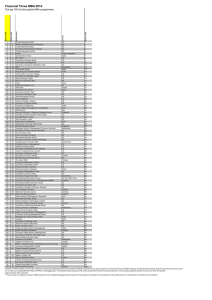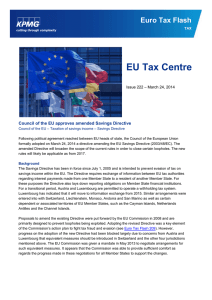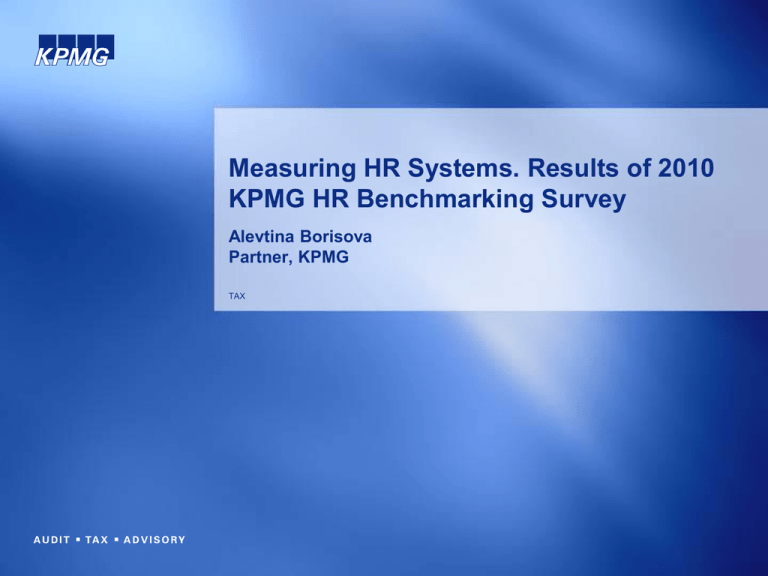
Measuring HR Systems. Results of 2010
KPMG HR Benchmarking Survey
Alevtina Borisova
Partner, KPMG
TAX
Human Resources Transformation
PEOPLE SERVICES
Since middle of 1990 - HR is no longer seen as administrators, but as
people to be involved in high-level strategic discussions, which means:
Technically
Per se
• Appreciation of the value of human assets
1. Shared Service Centers
2. Centers of Expertise
3. HR Business partners (HR generalists)
4. Advisor of Management
5. Center of Communication
• Strategic thinking
• Orientation to business needs and certain
targets
• Making HR function more efficient
How to set up closer connection between business and HR?
© 2010 ZAO KPMG, a company incorporated under the Laws of the Russian Federation, a subsidiary of KPMG Europe LLP, and a member firm of the KPMG network of independent member firms
affiliated with KPMG International Cooperative (“KPMG International”), a Swiss entity. All rights reserved. Printed in Russia.
2
Russian Practice
Subordination of HR Head
82.93%
Evaluating HR Effectiveness
81,58% of 2009 HR Benchmarking participants
evaluate HR Function effectiveness:
• Turnover rate
Deputy General Director
• Budget targets
General Director
12.20%
• Employee satisfaction surveys results
• Headcount of support functions
How to involve HR Head in strategy developing process?
What metrics to use for evaluating HR Function effectiveness?
How to define target values for these metrics?
© 2010 ZAO KPMG, a company incorporated under the Laws of the Russian Federation, a subsidiary of KPMG Europe LLP, and a member firm of the KPMG network of independent member firms
affiliated with KPMG International Cooperative (“KPMG International”), a Swiss entity. All rights reserved. Printed in Russia.
3
Approaches to Measure HR Effectiveness*
Approaches
Measurement focus
Value of Information
HR Case Studies
Qualitative Description with Data
Low
HR Auditing
Efficiency/Existence of Practices
Low
Program/Function
Low
HR Cost Monitoring
HR Management by Objectives Goal Setting for HR Performance Measures
Surveys
HR Key Indicators
ROI
HR Benchmarking
Attitudes/Perceptions
Moderate
Moderate
Program/Function Performance Measures
High
Benefits vs. Costs
High
Performance Measures/Practices
High
*Jack J. Phillips – The Human Resources Scorecard: Measuring the Return on investment
© 2010 ZAO KPMG, a company incorporated under the Laws of the Russian Federation, a subsidiary of KPMG Europe LLP, and a member firm of the KPMG network of independent member firms
affiliated with KPMG International Cooperative (“KPMG International”), a Swiss entity. All rights reserved. Printed in Russia.
4
What is HR Benchmarking
HR Benchmarking is the comparison of the numerical and qualitative indicators of a
company’s HR management system to the same indicators of other companies.
KPMG HR Benchmarking covers over 100
benchmarks in the following areas:
• Financial and Statistical Data
• Headcount and Responsibilities of the Support
•
•
•
•
Functions (HR and Finance)
Compensation and Benefits
Recruitment and Onboarding
Training and Development
Company Image and Corporate Culture
Assessing the
efficiency of HR
management
processes
Collecting
measurable data
characterizing HR
management system
•
•
•
•
•
•
•
•
•
Revenue per employee
Personnel costs as % of revenue
Personnel costs per employee
Payroll as % of total personnel costs
Personnel Turnover
HR Function FTE Ratio
Costs of various benefits per employee
Percentage of vacancies filled
Training costs per employee
Headcount planning
and the budgeting of
HR costs
Assessing HR ROI
© 2010 ZAO KPMG, a company incorporated under the Laws of the Russian Federation, a subsidiary of KPMG Europe LLP, and a member firm of the KPMG network of independent member firms
affiliated with KPMG International Cooperative (“KPMG International”), a Swiss entity. All rights reserved. Printed in Russia.
5
Headcount and personnel costs
Personnel costs as a percent of revenue
(median)
Headcount by employee category
(% of total headcount, median)
1.58%
11.68%
27.29%
68.41%
35.51%
Top
Managers
Top
Management
Middle
MiddleManagers
Management
Specialists
Specialists
Production
Blue
collars workers
Sales
employees
Sales
Specialists
Support
Supportemployees
Staff
23,5%
12,8%
11,6%
7,9%
3.60%
0%
20%
40%
60%
80%
0%
Banking
Finance
Banks
andand
finance
companies
Industrial Products
Production
and
automotive
Headquarters
FMCG
FMCG
and Farmacy
Pharmaceuticals
20%
40%
© 2010 ZAO KPMG, a company incorporated under the Laws of the Russian Federation, a subsidiary of KPMG Europe LLP, and a member firm of the KPMG network of independent member firms
affiliated with KPMG International Cooperative (“KPMG International”), a Swiss entity. All rights reserved. Printed in Russia.
6
Salary Dynamics Prognosis for 2010-2011
January-April 2010
No changes
38%
April
34%
January
11%
M arch
9%
February
6%
Tw ice and more
2%
0%
5%
10%
15%
20%
25%
30%
35%
40%
2010 salary changes, by employee category
Median
Total
25th Percentile 75th Percentile
Average
10%
10%
8%
12%
Top Managem ent
10%
11%
9%
11%
Middle Managem ent
10%
12%
8%
12%
Specialists
10%
11%
8%
12%
Production Workers
11%
11%
9%
12%
Sales Specialists
Support Staff
10%
10%
11%
10%
9%
8%
13%
12%
© 2010 ZAO KPMG, a company incorporated under the Laws of the Russian Federation, a subsidiary of KPMG Europe LLP, and a member firm of the KPMG network of independent member firms
affiliated with KPMG International Cooperative (“KPMG International”), a Swiss entity. All rights reserved. Printed in Russia.
7
Changes to Bonus Plans in 2009-2010
2009 Dynamics
Changes to Bonus Plans in 2009
Change of terms
Reduction of plans
Increase of plans
No Changes
Managem ent
15%
15%
6%
67%
Sales Departm ents
Other Em ployees
20%
11%
9%
13%
9%
2%
63%
74%
2010 Dynamics
Changes to Bonus Plans in 2010
Managem ent
Sales Departm ents
Other Em ployees
Change of terms
Reduction of plans
Increase of plans
No Changes
8%
-
6%
86%
19%
6%
-
6%
4%
75%
89%
© 2010 ZAO KPMG, a company incorporated under the Laws of the Russian Federation, a subsidiary of KPMG Europe LLP, and a member firm of the KPMG network of independent member firms
affiliated with KPMG International Cooperative (“KPMG International”), a Swiss entity. All rights reserved. Printed in Russia.
8
Benefits
The most widespread benefits
95%
Mobile phone compensation
90%
Health insurance
71%
Welfare assistance
63%
Corporate cars
61%
Life insurance
51%
Sick leave compensation
46%
Maternity leave compensation
44%
Meals
41%
Per diem above statutory norms
32%
Corporate discounts for certain services
27%
Sickness without medical certificate
24%
Company products at a discount
0%
20%
40%
60%
80%
100%
% of all participants
© 2010 ZAO KPMG, a company incorporated under the Laws of the Russian Federation, a subsidiary of KPMG Europe LLP, and a member firm of the KPMG network of independent member firms
affiliated with KPMG International Cooperative (“KPMG International”), a Swiss entity. All rights reserved. Printed in Russia.
9
Changes to Benefits in 2009-2010
Changes to Benefits in 2009
(% of all replies)
No
82%
Reduction of plans
9%
Increase of plans
5%
Change of terms
5%
0%
20%
40%
60%
80%
100%
Changes to Benefits in 2010
(% of all replies)
No
76%
Increase of plans
13%
Change of terms
7%
Reduction of plans
4%
0%
20%
40%
60%
80%
© 2010 ZAO KPMG, a company incorporated under the Laws of the Russian Federation, a subsidiary of KPMG Europe LLP, and a member firm of the KPMG network of independent member firms
affiliated with KPMG International Cooperative (“KPMG International”), a Swiss entity. All rights reserved. Printed in Russia.
10
Personnel Turnover
Turnover Causes Rank
Unappropritae
Compensationsalary level
Career
and professional
growth and
Lack
of opportunity
for professional
career growth
Personalreasons
reasons
Personal
Working
Workingconditions
conditions
Personnel Turnover
21%
12%
9%
5,6%
Banking and Finance
Banks
and Financial
Pharmaceuticals
companies
FMCG
FMCGand Farmacy
Production
Industrial Products
11,3%
companies
AllAllcompanies
© 2010 ZAO KPMG, a company incorporated under the Laws of the Russian Federation, a subsidiary of KPMG Europe LLP, and a member firm of the KPMG network of independent member firms
affiliated with KPMG International Cooperative (“KPMG International”), a Swiss entity. All rights reserved. Printed in Russia.
11
Recruiting
Percentage of vacancies filled
96.08%
The number of vacancies filled by recruitment agencies
18.03%
The number of vacancies filled by internal candidates
16.67%
The number of vacancies filled by internal
candidates (median)
Banking and Finance
10.00%
Industrial Products
25.75%
Pharmaceuticals
FMCG
16.61%
17.57%
0%
5%
10%
15%
20%
25%
30%
© 2010 ZAO KPMG, a company incorporated under the Laws of the Russian Federation, a subsidiary of KPMG Europe LLP, and a member firm of the KPMG network of independent member firms
affiliated with KPMG International Cooperative (“KPMG International”), a Swiss entity. All rights reserved. Printed in Russia.
12
Training
Number of trained employees
58.78%
Number of employees trained by external providers
21.05%
Training hours per 1 employee
7
Methods of evaluating the effectiveness of training
Методы оценки эффективности обучения
Employees' satisfaction with learning
82.86%
Measuring employees' knowledge and skills
change
65.71%
Evaluation of employees behaviour change after
learning
34.29%
HC ROI measurement
2.86%
0%
20%
40%
60%
80%
100%
© 2010 ZAO KPMG, a company incorporated under the Laws of the Russian Federation, a subsidiary of KPMG Europe LLP, and a member firm of the KPMG network of independent member firms
affiliated with KPMG International Cooperative (“KPMG International”), a Swiss entity. All rights reserved. Printed in Russia.
13
Talent and Succession Pools
Succession Pool
Talent Pool
Number of employees (as % of average headcount)
3.17%
2.15%
Number of filled vacancies
3.17%
2.15%
Turnover
1%
3.33%
© 2010 ZAO KPMG, a company incorporated under the Laws of the Russian Federation, a subsidiary of KPMG Europe LLP, and a member firm of the KPMG network of independent member firms
affiliated with KPMG International Cooperative (“KPMG International”), a Swiss entity. All rights reserved. Printed in Russia.
14
Motivation and Company Image
90% of all participants
Non-financial motivation programs /
recognition programs
• Professionalism rewards
• Loyalty rewards
• Rewards to anniversaries, holidays
67% of all participants
Regular employee satisfaction
surveys
• Employee satisfaction surveys on annual basis
81% of all participants
Building image among employees
External image programs
• Corporate events
• Internal communications (corporate media, etc.)
• Sponsorship / charity (71%)
• Employer brand programs (54%)
© 2010 ZAO KPMG, a company incorporated under the Laws of the Russian Federation, a subsidiary of KPMG Europe LLP, and a member firm of the KPMG network of independent member firms
affiliated with KPMG International Cooperative (“KPMG International”), a Swiss entity. All rights reserved. Printed in Russia.
15
The information contained herein is of a general nature and is not intended to address the circumstances of any particular individual or entity. Although
we endeavor to provide accurate and timely information, there can be no guarantee that such information is accurate as of the date it is received or that it
will continue to be accurate in the future. No one should act on such information without appropriate professional advice after a thorough examination of
the particular situation.
Presentor’ detailes:
Alevtina Borisova
Partner
Tax and legal
ABorisova@kpmg.ru
+7 (495) 937 4477
ZAO KPMG
www.kpmg.ru
© 2010 ZAO KPMG, a company incorporated under the Laws of the Russian Federation, a subsidiary of KPMG Europe LLP, and a member firm of the KPMG network of independent member firms
affiliated with KPMG International Cooperative (“KPMG International”), a Swiss entity. All rights reserved. Printed in Russia.
16

